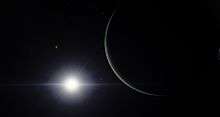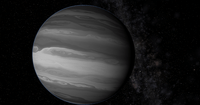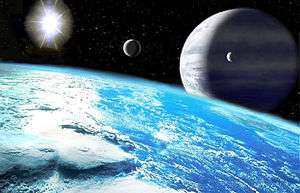Upsilon Andromedae d
Upsilon Andromedae d (υ Andromedae d, abbreviated Upsilon And d, υ And d), formally named Majriti /mædʒˈraɪti/, is a super-Jupiter exoplanet orbiting within the habitable zone of the Sun-like star Upsilon Andromedae A, approximately 44 light-years (13.5 parsecs, or nearly 4.163×1014 km) away from Earth in the constellation of Andromeda. Its discovery made it the first multiplanetary system to be discovered around a main sequence star, and the first such system known in a multiple star system. The exoplanet was found by using the radial velocity method, where periodic Doppler shifts of spectral lines of the host star suggest an orbiting object.
 | |
| Discovery | |
|---|---|
| Discovered by | Butler, Marcy et al. |
| Discovery site | California and Carnegie Planet Search |
| Discovery date | April 15, 1999 |
| Radial velocity | |
| Orbital characteristics | |
| Apastron | ~478 Gm |
| Periastron | ~282 Gm |
| ~380 Gm | |
| Eccentricity | 0.299±0.072[1] |
| 1276.46±0.57[1] d ~3.49626[1] y | |
| Inclination | 23.758 ± 1.316[2] |
| 4.073 ± 3.301[2] | |
| 2,450,059 ± 3.495[2] | |
| 252.991 ± 1.311[2] | |
| Semi-amplitude | 68.14 ± 0.45[1] |
| Star | Upsilon Andromedae A |
| Physical characteristics | |
Mean radius | ~1.02 RJ |
| Mass | 10.25+0.7 −3.3[2] MJ |
| Temperature | 218 K (−55 °C; −67 °F) |
Name
In July 2014 the International Astronomical Union launched a process for giving proper names to certain exoplanets and their host stars.[3] The process involved public nomination and voting for the new names.[4] In December 2015, the IAU announced the winning name was Majriti for this planet.[5] The winning name was submitted by the Vega Astronomy Club of Morocco, honoring the 10th century scientist Maslama al-Majriti.[6]
Characteristics
Mass, radius and temperature

Upsilon Andromedae d is a super-Jupiter, an exoplanet that has a mass larger than that of the planet Jupiter. It has a temperature of 218 K (−55 °C; −67 °F).[7] It has a mass of 10.25 MJ[2] and a likely radius of around 1.02 RJ based on its mass.
Host star
The planet orbits a (F-type) star named Upsilon Andromedae A. The star has a mass of 1.27 M☉ and a radius of around 1.48 R☉. It has a temperature of 6074 K and is 3.12 billion years old. In comparison, the Sun is about 4.6 billion years old[8] and has a temperature of 5778 K.[9] The star is slightly metal-rich, with a metallicity ([Fe/H]) of 0.09, or about 123% of the solar amount. Its luminosity (L☉) is 3.57 times that of the Sun.
The star's apparent magnitude, or how bright it appears from Earth's perspective, is 4.09. Therefore, Upsilon Andromedae can be seen with the naked eye.
Orbit
Upsilon Andromedae d orbits its star nearly every 3.5 years (about 1,276 days) in an eccentric orbit, more eccentric than that of any of the known planets in the Solar System.[10] To explain the planet's orbital eccentricity, some have proposed a close encounter with a now-lost outer planet of Upsilon Andromedae A. The encounter would have moved planet "d" into an eccentric orbit closer to the star and ejected the outer planet.[11][12]
Habitability

Upsilon Andromedae d lies in the habitable zone of Upsilon Andromedae A as defined both by the ability for an Earthlike world to retain liquid water at its surface and based on the amount of ultraviolet radiation received from the star.[13]
For a stable orbit the ratio between the moon's orbital period Ps around its primary and that of the primary around its star Pp must be < 1/9, e.g. if a planet takes 90 days to orbit its star, the maximum stable orbit for a moon of that planet is less than 10 days.[14][15] Simulations suggest that a moon with an orbital period less than about 45 to 60 days will remain safely bound to a massive giant planet or brown dwarf that orbits 1 AU from a Sun-like star.[16] In the case of Upsilon Andromedae d, the orbital period would have to be no greater than 120 days (around 4 months) in order to have a stable orbit.
Tidal effects could also allow the moon to sustain plate tectonics, which would cause volcanic activity to regulate the moon's temperature[17][18] and create a geodynamo effect which would give the satellite a strong magnetic field.[19]
To support an Earth-like atmosphere for about 4.6 billion years (the age of the Earth), the moon would have to have a Mars-like density and at least a mass of 0.07 M⊕.[20] One way to decrease loss from sputtering is for the moon to have a strong magnetic field that can deflect stellar wind and radiation belts. NASA's Galileo's measurements hints large moons can have magnetic fields; it found that Jupiter's moon Ganymede has its own magnetosphere, even though its mass is only 0.025 M⊕.[16]
Discovery and further studies
Upsilon Andromedae d was detected by measuring variations in its star's radial velocity as a result of the planet's gravity. This was done by making precise measurements of the Doppler shift of the spectrum of Upsilon Andromedae A. At the time of discovery, Upsilon Andromedae A was already known to host one extrasolar planet, the hot Jupiter Upsilon Andromedae b; however, by 1999, it was clear that the inner planet could not explain the velocity curve.
In 1999, astronomers at both San Francisco State University and the Harvard-Smithsonian Center for Astrophysics independently concluded that a three-planet model best fit the data.[21] The two new planets were designated Upsilon Andromedae c and Upsilon Andromedae d.
Preliminary astrometric measurements suggest the orbit of Upsilon Andromedae d may be inclined at 155.5° to the plane of the sky.[22] However, these measurements were later proved useful only for upper limits;[23] , and contradict even the inner planet u And b's inclination of >30°. The mutual inclination between c and d meanwhile is 29.9 degrees.[2] The true inclination of Upsilon Andromedae d was determined as 23.8° after combined results were measured from the Hubble Space Telescope and radial velocity measurements.[2]
When it was discovered, a limitation of the radial velocity method used to detect Upsilon Andromedae d is that the orbital inclination is unknown, and only a lower limit on the planet's mass can be obtained, which was estimated to be about 4.1 times as massive as Jupiter. However, by combining radial velocity measurements from ground-based telescopes with astrometric data from the Hubble Space Telescope, astronomers have determined the orbital inclination as well as the actual mass of the planet, which is about 10.25 times the mass of Jupiter.[2]
Trivia
See also
References
- Ligi, R.; et al. (2012). "A new interferometric study of four exoplanet host stars : θ Cygni, 14 Andromedae, υ Andromedae and 42 Draconis". Astronomy & Astrophysics. 545: A5. arXiv:1208.3895. Bibcode:2012A&A...545A...5L. doi:10.1051/0004-6361/201219467.
- McArthur, Barbara E.; et al. (2010). "New Observational Constraints on the υ Andromedae System with Data from the Hubble Space Telescope and Hobby Eberly Telescope" (PDF). The Astrophysical Journal. 715 (2): 1203. Bibcode:2010ApJ...715.1203M. doi:10.1088/0004-637X/715/2/1203.
- NameExoWorlds: An IAU Worldwide Contest to Name Exoplanets and their Host Stars. IAU.org. 9 July 2014
- NameExoWorlds The Process
- Final Results of NameExoWorlds Public Vote Released, International Astronomical Union, 15 December 2015.
- NameExoWorlds The Approved Names
- http://www.hpcf.upr.edu/~abel/phl/hec_plots/hec_orbit/hec_orbit_ups_And_d.png
- Fraser Cain (16 September 2008). "How Old is the Sun?". Universe Today. Retrieved 19 February 2011.
- Fraser Cain (September 15, 2008). "Temperature of the Sun". Universe Today. Retrieved 19 February 2011.
- Butler, R. P.; et al. (2006). "Catalog of Nearby Exoplanets". The Astrophysical Journal. 646 (1): 505–522. arXiv:astro-ph/0607493. Bibcode:2006ApJ...646..505B. doi:10.1086/504701. (web version)
- Ford, Eric B.; et al. (2005). "Planet-planet scattering in the upsilon Andromedae system". Nature. 434 (7035): 873–876. arXiv:astro-ph/0502441. Bibcode:2005Natur.434..873F. doi:10.1038/nature03427. PMID 15829958.
- Rory Barnes; Richard Greenberg (2008). "Extrasolar Planet Interactions". arXiv:0801.3226v1 [astro-ph].
- Buccino, Andrea P.; et al. (2006). "Ultraviolet Radiation Constraints around the Circumstellar Habitable Zones". Icarus. 183 (2): 491–503. arXiv:astro-ph/0512291. Bibcode:2006Icar..183..491B. doi:10.1016/j.icarus.2006.03.007.
- Kipping, David (2009). "Transit timing effects due to an exomoon". Monthly Notices of the Royal Astronomical Society. 392: 181–189. arXiv:0810.2243. Bibcode:2009MNRAS.392..181K. doi:10.1111/j.1365-2966.2008.13999.x.
- Heller, R. (2012). "Exomoon habitability constrained by energy flux and orbital stability". Astronomy & Astrophysics. 545: L8. arXiv:1209.0050. Bibcode:2012A&A...545L...8H. doi:10.1051/0004-6361/201220003. ISSN 0004-6361.
- Andrew J. LePage. "Habitable Moons:What does it take for a moon — or any world — to support life?". SkyandTelescope.com. Retrieved 2011-07-11.
- Glatzmaier, Gary A. "How Volcanoes Work – Volcano Climate Effects". Retrieved 29 February 2012.
- "Solar System Exploration: Io". Solar System Exploration. NASA. Retrieved 29 February 2012.
- Nave, R. "Magnetic Field of the Earth". Retrieved 29 February 2012.
- "In Search Of Habitable Moons". Pennsylvania State University. Retrieved 2011-07-11.
- Butler, R. Paul; et al. (1999). "Evidence for Multiple Companions to υ Andromedae". The Astrophysical Journal. 526 (2): 916–927. Bibcode:1999ApJ...526..916B. doi:10.1086/308035.
- Han, Inwoo; et al. (2001). "Preliminary Astrometric Masses for Proposed Extrasolar Planetary Companions". The Astrophysical Journal. 548 (1): L57–L60. Bibcode:2001ApJ...548L..57H. doi:10.1086/318927.
- Pourbaix, D. & Arenou, F. (2001). "Screening the Hipparcos-based astrometric orbits of sub-stellar objects". Astronomy and Astrophysics. 372 (3): 935–944. arXiv:astro-ph/0104412. Bibcode:2001A&A...372..935P. doi:10.1051/0004-6361:20010597.
- "Exoplanet Names".